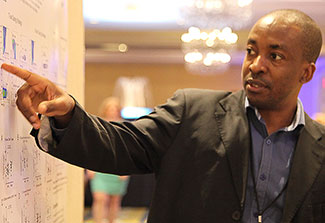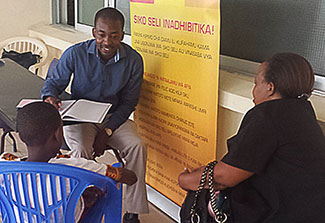
Profile: Fogarty Global Health Fellow Dr Emmanuel Balandya studies sickle cell immunity
January / February 2017 | Volume 16, Issue 1

Photo by Karin Zeitvogel
Dr. Emmanuel Balandya explains his Fogarty Global Health
Fellowship research on sickle cell anemia at a poster session
in July 2016.
Fellowship research on sickle cell anemia at a poster session
in July 2016.
By Karin Zeitvogel
The brother and sister playing in the clinic at Dar-es-Salaam's Muhimbili National Hospital reminded Dr. Emmanuel Balandya why he chose to focus his research as a Fogarty Global Health Fellow on the role of immune cells in sickle cell disease.
"Both had sickle cell anemia, which is the most common, and often most severe, form of sickle cell disease," Balandya said. "Thinking about what they will go through - especially in an African setting - reminded me of how much work remains to be done on sickle cell, and how wide the knowledge gaps are."
Sickle cell disease is a group of inherited disorders that cause hemoglobin, the protein in blood that carries oxygen around the body, to change red blood cells into a crescent - or sickle - shape, and become inflexible and sticky. Sickled red cells can cause a blockage in the circulatory system, preventing blood from carrying oxygen to tissues and organs, and causing pain and sometimes death. Most babies with sickle cell disease are born in Africa, and 50 to 80 percent of them die before the age of 5. The most common cause of death in children with sickle cell is infection. Tanzania ranks fourth in the world for sickle cell disease prevalence after Nigeria, the Democratic Republic of Congo and India.
Balandya’s project - which was supported by the National Heart, Lung and Blood Institute (NHLBI), Fogarty and the University of California Global Health Institute (UCGHI) - focused on the role played by T and B lymphocytes in the immunity of Tanzanian children with sickle cell anemia. In a review article published in the American Journal of Hematology, Balandya noted there is a “critical shortage of insight” on immunity in sickle cell anemia, and particularly on acquired immunity. Limited studies have indicated dysfunction of T and B cells in patients with sickle cell anemia, which may affect vaccine reactivity, Balandya said in the article. Enhancing understanding of the immune function in sickle cell anemia would help improve vaccine efficacy and could reduce transplant rejections and autoimmune diseases, he hypothesized.
Support from the Fogarty Global Health fellowship was vital to allowing Balandya "to combine the knowledge I gained in the U.S. - where I did my Ph.D. at Dartmouth College on a Fogarty AIDS International Training and Research Program scholarship, and postdoctoral work at Harvard Medical School - with my medical training, and apply them to research on a disease that's a serious challenge in sub-Saharan Africa," he said. "This grant was the only bridging support I got and allowed me to continue my research after returning to Tanzania from the U.S."

Photo courtesy of Dr. Emmanuel Balandya
Dr. Emmanuel Balandya (center) consults with a patient with
sickle cell disease and his mother at a clinic in
Dar-es-Salaam, Tanzania.
sickle cell disease and his mother at a clinic in
Dar-es-Salaam, Tanzania.
During the fellowship, Balandya had the opportunity to work with renowned sickle cell experts Dr. Julie Makani of Muhimbili University of Health and Allied Sciences, Dr. Stephen Obaro of the University of Nebraska Medical Center and Dr. Teri Reynolds of the University of California, San Francisco. He also was able to visit the NIH, where he met with leaders including the directors of Fogarty and the NHLBI, and gained insight into which research and training grants are available to young African investigators.
Balandya said he hopes data produced by his research will result in more cost-effective sickle cell interventions being adapted for and introduced in Africa.
"Governments have rolled out some interventions, such as vaccinations against secondary illnesses, which have proven effective elsewhere in reducing deaths from sickle cell disease," Balandya said. "But in Africa, sickle cell has to compete for limited resources with illnesses like HIV, TB or malaria. Research initiatives help promote care for people living with sickle cell, but too few benefit. So our hope is that successful outcomes from projects like ours will convince African governments to mainstream more interventions for sickle cell."
More Information
- About the Global Health Program for Fellows and Scholars
- Featured Profiles of Fogarty Fellows and Scholars
- University of California Global Health Institute
- Critical Review article: Alteration of lymphocyte phenotype and function in sickle cell anemia: Implications for vaccine responses
American Journal of Hematology, July 14, 2016 - Muhimbili University of Health and Allied Sciences
To view Adobe PDF files, download current, free accessible plug-ins from Adobe's website.





















.png)









No hay comentarios:
Publicar un comentario